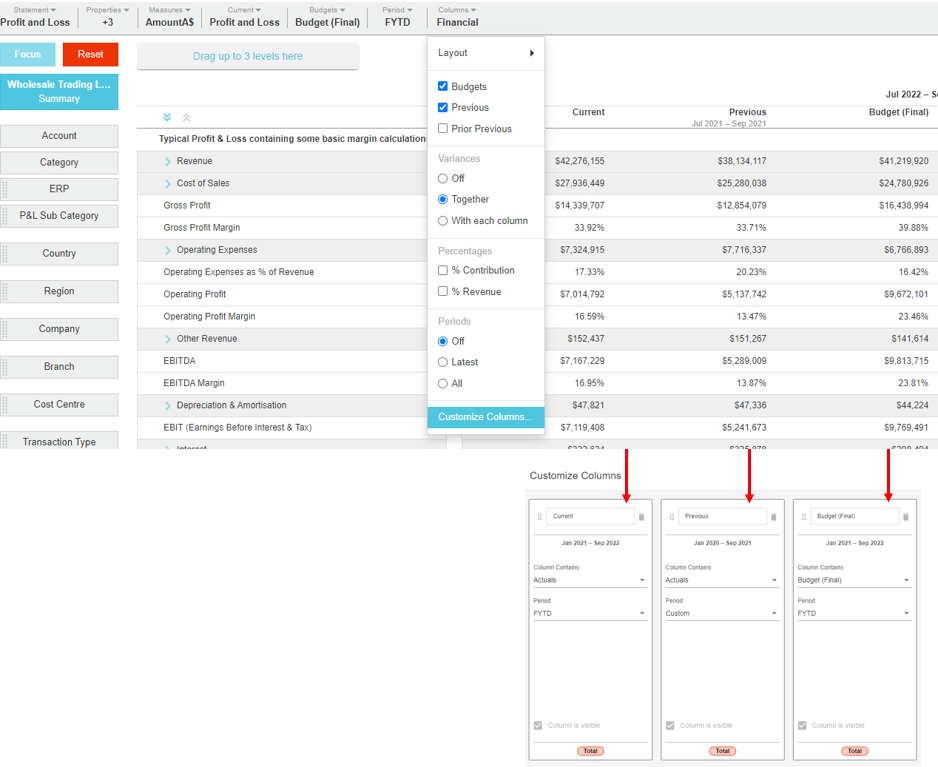Versions Compared
Key
- This line was added.
- This line was removed.
- Formatting was changed.
If you have permission to customize statements, you can design your own version of a Profit and Loss statement and Balance Sheet statement by defining the columns that they contain, giving you much greater flexibility in the layout and the analysis capabilitiesanalysis capabilities. You can use the custom measures option to insert additional columns into your financial statement, to enable the analysis of multiple measures from the same data stream within the financial statement. You can save your column configurations in the form of layouts, then when you switch to a different version of the Profit and Loss statement, you can apply the saved layout. So you can mix and match your column layouts to have lots of versions of each statement.
View the column configuration
Within a Profit and Loss or Balance Sheet statement, click the Columns > Customize Columns. The Customize Columns window displays a representation of the columns that are currently in the statement.

You can can edit or delete the existing columns and add new columns, as outlined below.
Edit
or hidea column
Edit the name of the column, if required: Click in the name box and overwrite the name as required.
In the Customize Columns window, you can change the name and setup of the existing columns. The available setup options depend on the type of column (expand the sections below) and might include a Measures setting if you opt to use custom measures (see
tablethe section below).
SelectUse custom measures
In the Customize Columns window, select the Use custom measures checkbox in the top-left corner to enable the Measures setting for each of the Total columns, then proceed to select a measure from the list for each of those columns. See Use multiple measures in financial statements for more information.
Hide a column
In the Customize Columns window, select the Column is Hidden checkbox, if you want to hide the column in the statement. This option is useful if you are using a Variance column but do not want to display the two underlying columns.
Similarly, if you are using a Calculation column (coming soon), you might want to display the result of a calculation but hide the elements of that calculation.Continue customizing the columns or click OK to view your changes in the statement.
Move a column
Click the column’s Delete button. The column is deleted immediately.
Continue customizing the columns or click OK to view your changes in the statement.
Move a column
ClickIn the Customize Columns window, click and hold the column’s Move button on the left side of the name (a blue box displays around the row), then drag the item left or right to its new position.
Continue customizing the columns or click OK to view your changes in the statementDelete a column
In the Customize Columns window, click the column’s Delete button. The column is deleted immediately.
Add a new column
This is the type of column formatClick In the Customize Columns window, click the New Column button and select one of the following column types: Total, Variance, Periods, Calculation or Spacer (see descriptions in table below Sum (expand the sections below for more information).
Enter a name for the column.
Set up the column as required (see setup in table belowexpand the sections below for more information).
Move the column to another position (see above), if required.
Continue customizing the columns or click Click OK to view your changes in the statement.
Column Type
Description and setup
Total
(Optional) Save your new column configuration as a layout.
| Expand | ||
|---|---|---|
| ||
The Total column format is used by the standard Current, Previous and Budget columns in the Columns menu.
|
|
|
|
| Expand | ||
|---|---|---|
|
| |
The Variance column format is used by the standard Variance column in the Columns menu. It displays the difference between the values in two other columns, such as the Current and Previous columns. Whereas the standard setup displays both the value and percentage of the variance, when customizing this column you have the option to display the value only or the percentage only. You can also select the columns on which to calculate the variance.
|
| Expand | ||
|---|---|---|
|
| |
The Sum column type allows you to add the values in two columns and display the sum |
in a new column. You can add any two of the Total columns together, and you can add a column to itself.
|
Periods
|
Calculation
|
Spacer
|
|
Save your new column configuration as a layout. |
On this page
| Table of Contents | ||||
|---|---|---|---|---|
|